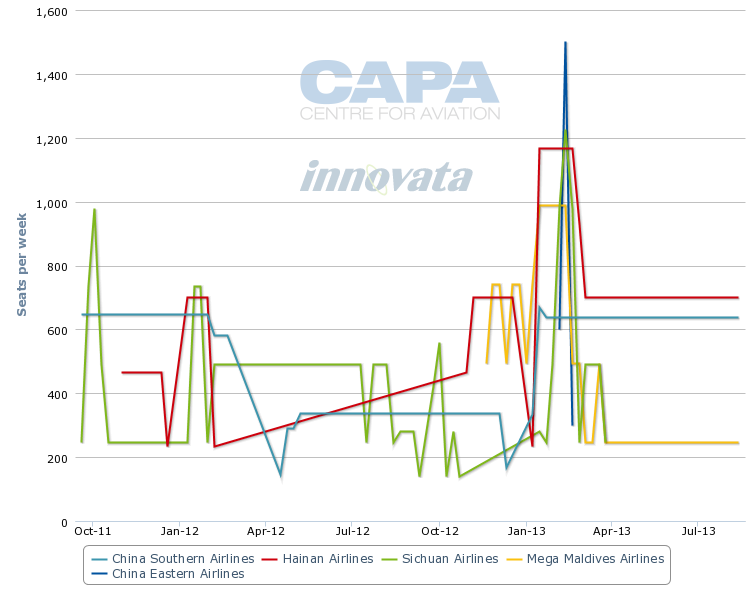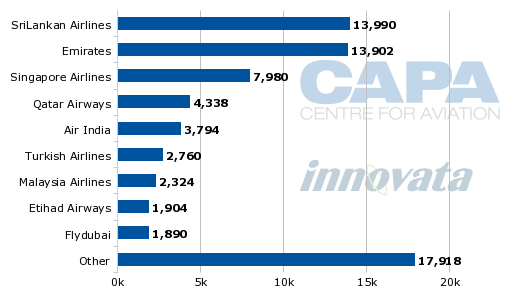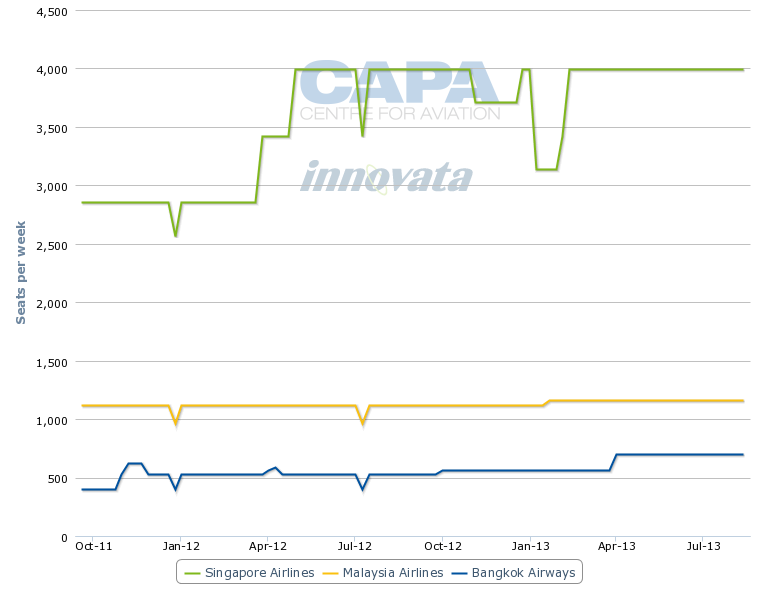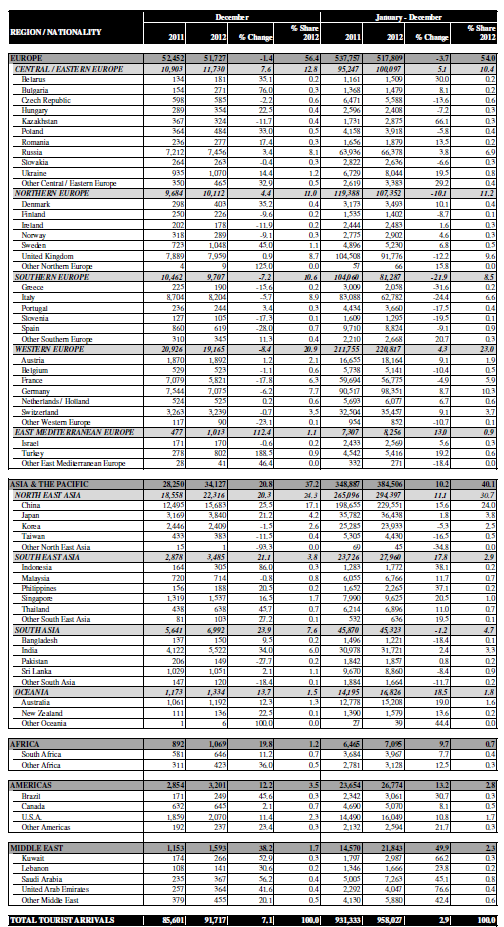China-Maldives airline market grows rapidly; MEGA Maldives, SIA, SriLankan & Chinese carriers win
The small but lucrative Maldives market continues to see rapid growth, driven by increasing demand from China. The Maldives has emerged in recent years as a popular top end tourism destination for the Chinese. Mainland Chinese carriers have responded by adding flights along with Singapore Airlines (SIA), which has doubled capacity to the Maldives over the last two years on the back of increasing China-Maldives traffic.
SriLankan Airlines, the largest carrier in the Maldives, also has cashed in on the booming China-Maldives market as its traditional Europe-Maldives business has been impacted by rapid expansion from the Gulf carriers. The huge opportunities in the China-Maldives market also precipitated the 2011 launch of long-haul leisure carrier MEGA Maldives Airlines, which allocates almost all of its capacity to greater China.
China-Maldives market has grown by almost 300% in three years
Chinese tourist arrivals in the Maldives has increased by almost 300% over the last three years from about 60,000 in 2009 to about 230,000 in 2012, according to Maldives Ministry of Tourism data. Chinese nationals accounted for 24% of tourists in the Maldives in 2012, making China for the first time a bigger source of tourists for the Maldives than western Europe.
Western Europe accounted for 22% of all tourist arrivals as the western Europe-Maldives market grew by 4% to about 220,000. Back in 2009 China accounted for only 9% of tourists while western Europe, which traditionally has been the largest source market for tourists in the Maldives, accounted for 26%.
In 2012 overall tourism growth in the Maldives slowed due to political instability as the previous democratically-elected president was ousted in an alleged Feb-2012 coup. But the China-Maldives market still grew by 16% last year from about 200,000 to about 230,000 tourist arrivals. China accounted for all the growth in the Maldives in 2012 as the overall tourist numbers increased by 27,000 to 958,000, representing year-over-year growth of 3%.
During more stable times in 2011 growth in the China-Maldives market surged by 67% while overall growth in tourist arrivals increased by 18%. This followed 96% growth in Chinese tourist arrivals and 21% overall growth in 2010. Chinese nationals accounted for 57% of the total year-over-year increase in tourists recorded by the Maldives Ministry of Tourism in 2011 and 43% of the total from 2010.
While the growth from 2010 and 2011 will be hard to repeat, the China-Maldives market is expected to continue growing at rapid double-digit clips. China's wealthy population continues to grow as the country's economy expands, leading to more Chinese travelling overseas to top end tourism destinations. The Maldives, with its over 100 resorts and 26 Indian Ocean atolls, is well positioned to attract high end leisure traffic from China and benefit as the China outbound tourist market continues to grow.
Four Chinese airlines now serve the Maldives
Chinese carriers over the last two years have responded to the surge in demand for China-Maldives services by launching and adding services to the Maldivian capital of Male. There are now four Chinese carriers serving Male - China Eastern, China Southern, Hainan Airlines and Sichuan Airlines.
Hainan serves Male from Beijing, Sichuan from Chengdu and China Southern from Guangzhou while China Eastern serves Male from Kunming via Colombo in Sri Lanka. Hainan and China Eastern currently operate three weekly flights to Male while China Southern and Sichuan operate two weekly flights. Currently the four carriers offer about 2,300 weekly seats to Male (includes China Eastern's capacity via Colombo), which is about 50% more than what the same four carriers operated to Male during this period last year.
Maldives to China capacity by carrier (one-way seats per week): 19-Sep-2012 to 18-Aug-2013
All four of the Chinese carriers fluctuate their Male schedules based on seasonal demand and bookings from tour agents, which account for a majority of bookings on China-Maldives routes. The general trend has been more capacity but the increases have not nearly been sufficient to absorb the rapid rise in traffic between the two countries.
While China now accounts for about one-quarter of tourist arrivals in the Maldives, Chinese carriers currently only account for 7% of total international capacity at Male. Not a single Chinese carrier is currently among the 10 largest international carriers serving Male.
Male international capacity by carrier (weekly seats): 25-Feb-2013 to 3-Mar-2013
MEGA Maldives serves five points in greater China with low frequency schedule
MEGA Maldives provides approximately another 3,000 weekly one-way seats in the Maldives-China market. The leisure carrier was launched in mid-2011 by a group of US and Maldivian investors that recognised the rapid growth in the Maldives-China market and the lack of non-stop services between the two countries.
The Maldives has traditionally only had local carriers which serve the domestic market, with turboprops and seaplanes catering to tourists heading from the country's only international airport at Male to the dozens of islands which are too far from Male to be easily connected with speed boat. (The country's largest domestic carrier, Maldivian, also has limited international services to India but this does not overlap with MEGA which focuses on long-haul routes.)
See related article: Tourism-dependent Maldives welcomes new airline, MEGA Maldives
MEGA has focused almost entirely on building a niche between the Maldives and China, launching several low frequency routes to greater China. MEGA currently operates about 13 weekly flights to greater China, including: one to two weekly frequencies to Hangzhou; two to three weekly frequencies to Hong Kong, Chengdu and Shanghai; and three to four weekly frequencies to Beijing. The carrier's schedule fluctuates week to week. It also has previously served a sixth Chinese destination, Chongqing, on a seasonal basis but Chongqing is not part of MEGA's winter 2013 schedule.
MEGA, which operates one 757 and two 767s in three class configuration (economy, premium economy and business), is well positioned to continue expanding as the Maldives-China market continues to grow. With only about 5,000 weekly non-stop seats between the Maldives and China, the market is still significantly under-served - a fact exploited by other Asian carriers that serve the market on a sixth freedom basis.
Singapore Airlines smartly targets the China-Maldives market
SIA was the first carrier to respond to the lack of capacity in the China-Maldives market by promoting its services via Singapore. SIA traditionally operated four to seven weekly flights to Male, depending on the season. But in Mar-2011 SIA added a second flight that operated three days per week, resulting in 10 weekly frequencies and improving connections to the group's China network. In Mar-2012 SIA added four more weekly flights, again primarily in response to booming demand for China-Maldives services, giving it a double daily year-round service.
SIA is able to offer connections to 12 destinations in greater China, including five served by SIA and seven by its regional subsidiary SilkAir. Half of these destinations are now served with non-stop flights from Male by other carriers. But SIA still carries a large number of passengers to the six destinations served with non-stop flights by other carriers as its daily service is able to attract Chinese nationals wishing to spend less than a week at a Maldivian resort.
Wealthy Chinese are also attracted to SIA's renowned in-flight product in both cabins. While the Maldives is entirely a leisure destination, there is decent demand for premium cabin services between China and the Maldives, which SIA is able to mop up with its superior product and double daily service to Male.
SIA is currently the third largest carrier in Male with about 8,000 weekly seats, giving it an 11% share of total international capacity. In 2012 SIA had almost 200,000 arriving seats at Male. But Singaporeans only accounted for 9,600 tourist arrivals in the Maldives in 2012. This shows an overwhelming majority of SIA's passengers to and from Male are connecting in Singapore. (The 9,600 figure is somewhat misleading as the Maldives tracks tourists based on nationality rather than country of residence and Singapore has a large expatriate population, but even factoring in Singapore-based expatriates it is clear that SIA is carrying more Chinese than Singapore residents on its Male flights.)
Some of SIA's Male passengers connect to destinations in the Asia-Pacific region (includes Australia and New Zealand) other than China. But with China accounting for 77% of tourism arrivals from the Asia-Pacific region and 92% of tourism arrivals from Asia-Pacific excluding South Asia (a market SIA would not serve as it would require significant backtracking) it is safe to assume a majority of passengers on SIA's Male flights are originating in China.
SriLankan sees strong China-Maldives traffic despite double stop
SriLankan also has actively promoted over the last few years its connections between China and the Maldives. But SriLankan serves significantly fewer markets in greater China, four, and offers a less convenient product as its China-Maldives services require stops in both Colombo and Bangkok.
SriLankan, which plans to join the oneworld alliance in late 2013, is also unable to match SIA's schedules in the four Maldives-China markets the two carriers compete on - Beijing, Guangzhou, Hong Kong and Shanghai. SriLankan has more frequencies to Male than any other carrier, with five daily flights giving it 20% of total international capacity at Male. But it only operates five weekly flights to Beijing and Shanghai, four to Guangzhou and three to Hong Kong. SIA serves all these markets with multiple daily flights.
Despite these disadvantages SriLankan has been able to capture a large share of China-Maldives traffic by offering competitive pricing and exploiting the lack of overall capacity in the market. As CAPA reported on 27-Feb-2013, nearly half of SriLankan's passengers from its four destinations in greater China are heading to the Maldives. That means SriLankan allocates on average approximately 2,500 weekly one-way seats to the Maldives-China market, accounting for half of its 5,000 weekly one-way seats between Sri Lanka and China (including Hong Kong) and about 35% of its 7,000 weekly one-way seats between the Maldives and Sri Lanka. The 2,500 seats give SriLankan a share of the Maldives-China market that is similar in size to all Chinese carriers combined and likely bigger than SIA's share.
The China-Maldives market has become strategically important to SIA and SriLankan as it has offset decreases in other markets. SIA needs to find new markets from China such as China-Maldives to offset the loss of traffic over the last several years in other China sixth freedom markets, such as China-Europe, caused by the rapid expansion of the Gulf carriers in China. SriLankan meanwhile needs to find new markets from the Maldives to similarly offset the loss of traffic in other Maldives sixth freedom markets as a result of the Gulf carriers expanding into the Maldives. As CAPA previously reported:
While it now allocates a large portion of its Maldives seats to China (roughly one-third), SriLankan has historically carried a large number of passengers between the Maldives and Europe and between Maldives and India. But SriLankan has seen its Europe-Maldives traffic decrease over the last several years as Gulf carriers have launched services and steadily increased their capacity to Male. SriLankan previously routed some of its flights between Colombo and Europe via Male, including four weekly flights on a Colombo-Male-London Heathrow routing until 2012.
Most of SriLankan's Maldives passengers now connect onto the carrier's flights within Asia. The carrier's high frequency operation in Male is also attractive to oneworld carriers that serve Colombo or plan to serve Colombo as there would be a quick connection to the Maldives for essentially any flight arriving in Sri Lanka. SriLankan is now talking to oneworld members about improving their access to the Maldives market.
See related article: SriLankan Airlines focuses expansion on North Asia as it prepares to join oneworld
Gulf airlines have intensified competition in Europe-Maldives market
Europe is still a big market for the Maldives, with all regions of Europe accounting for 54% of tourist arrivals in 2012. Carriers from the Middle East now provide over 23,000 weekly seats in the Male market, accounting for over 30% of all international seats in the market. Almost all of this capacity is allocated to passengers originating in Europe as there were only 22,000 nationals from Middle Eastern countries that holidayed in the Maldives in 2012.
Five Middle Eastern carriers now serve Male - Emirates, Etihad, Qatar Airways, Oman Air and flydubai. Emirates is currently the second largest carriers in the Maldives market while Qatar is the fourth largest.
The remaining portion of the Maldives-Europe market is carried by European carriers. According to Innovata, seven European carriers currently operate scheduled services to Male - Aeroflot, Austrian, British Airways, Condor, Meridiana Fly, Transaero and Turkish. There are also several European charter carriers in the market.
Overall Male is now served by 22 foreign carriers, according to Innovata data. The other carriers serving Male include Air India, SpiceJet, Bangkok Airways and Malaysia Airlines (MAS). Air India and SpiceJet cater to the India-Maldives market rather than sixth freedom markets (SriLankan also carriers a large number of passengers from the Maldives to India via Colombo). Bangkok Airways is a small full-service carrier focusing on the Thailand-Maldives market.
MAS is therefore the only carrier other than SriLankan and SIA that is currently positioned to capture sixth freedom traffic between China and the Maldives. MAS has a small amount of capacity in the market, operating only daily 737-800 flights from Kuala Lumpur. But MAS is likely carrying a fair number of passengers between China and Maldives as Malaysia itself is a small source of tourists in the Maldives, accounting for less than 7,000 tourist arrivals in 2012. MAS, which operates to seven cities in greater China, could be enticed to increase capacity to Male to capture a greater share of the booming China-Maldives market.
Maldives to Southeast Asia capacity by carrier (one-way seats per week): 19-Sep-2012 to 18-Aug-2013
HK Airlines and KAL to launch Male services; more North Asian airlines will likely follow
Other Asian carriers will likely be similarly drawn to the Maldives market, starting with Hong Kong Airlines. The Hong Kong-based carrier is reportedly planning to launch scheduled services from Hong Kong to Male on 01-May-2013. Hong Kong Airlines previously served Male with charter flights and by launching scheduled flights will be able to tap into the booming mainland China-Maldives market. Hong Kong Airlines currently links Hong Kong with 15 destinations in mainland China.
Hong Kong Airlines' decision to enter the Maldives market could sway its much larger rival, Cathay Pacific Airways, to launch its own flights to Male. Cathay Pacific has been considering the Maldives market for some time, cognisant of the success rival SIA has had in Male and in particular the China-Maldives market. Cathay and its sister carrier Dragonair serve 20 cities in mainland China, which would give it an advantage over SIA should it launch flights to Male.
Meanwhile, Korean Air (KAL) will become the first North Asian carrier from outside greater China to serve Male on 09-Mar-2013, when it launches three weekly flights on a Seoul-Colombo-Male routing. The new service could be a toe in the water and potentially lead to non-stop flights between Korea and the Maldives. KAL could also potentially carry some passengers from northeast China, where it has a strong network, to the Maldives although the double stop and slightly circuitous routing could be a deterrent.
Korea accounted for about 24,000 tourist arrivals in the Maldives during 2012 (see background information). Japan is the second largest Asian country for tourists in the Maldives after China, accounting for 36,000 tourist arrivals in 2012. SIA and SriLankan, which serves Tokyo Narita with a non-stop flight from Colombo, are the main carriers catering to the Japan-Maldives market. KAL could also potentially capture some of this market, particularly if it later serves Male with a non-stop flight.
MEGA Maldives also has tested out the Maldives-Korea market with seasonal flights to Seoul. MEGA Maldives has been considering more regular flights to Korea and launching flights to Japan, potentially via mainland China.
Asia is MEGA's focus as it prefers to avoid highly competitive markets such as Europe. But while several Asian markets have potential for big growth from the Maldives, China has clearly emerged as the main growth market for the Maldives and this status will likely not change for the short to medium term.
More Chinese carriers are likely to take notice and launch services to the Maldives. But there will also continue to be plenty of room for growth for MEGA Maldives and sixth freedom carriers, led for now by SIA and SriLankan.
Background Information
Maldives tourist arrivals by nationality: 2012 vs 2011



